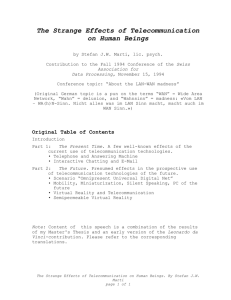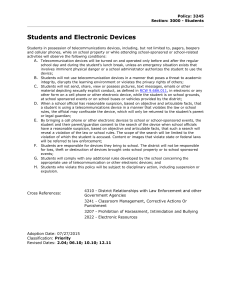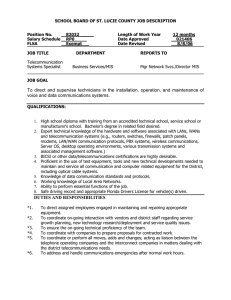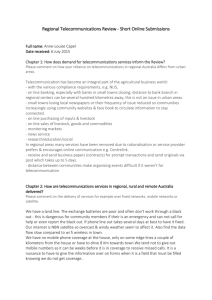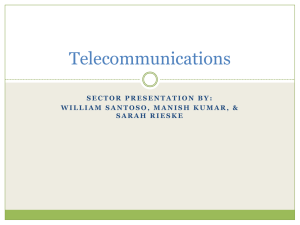ZEF Bonn
advertisement
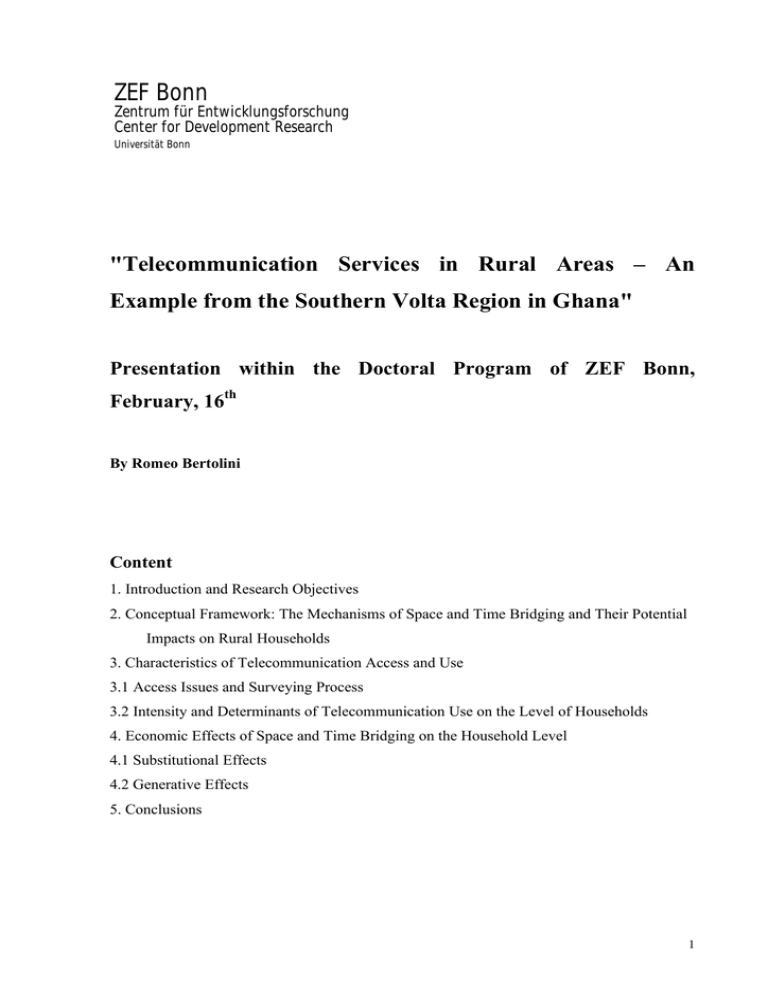
ZEF Bonn Zentrum für Entwicklungsforschung Center for Development Research Universität Bonn "Telecommunication Services in Rural Areas – An Example from the Southern Volta Region in Ghana" Presentation within the Doctoral Program of ZEF Bonn, February, 16th By Romeo Bertolini Content 1. Introduction and Research Objectives 2. Conceptual Framework: The Mechanisms of Space and Time Bridging and Their Potential Impacts on Rural Households 3. Characteristics of Telecommunication Access and Use 3.1 Access Issues and Surveying Process 3.2 Intensity and Determinants of Telecommunication Use on the Level of Households 4. Economic Effects of Space and Time Bridging on the Household Level 4.1 Substitutional Effects 4.2 Generative Effects 5. Conclusions 1 1. Introduction and Research Objectives The presented work focuses on the utilisation of telecommunication services (voice telephony and fax) on the level of rural households1 in Southern Ghana. This focus derives from the notion that urban centres of many countries in the developing world are significantly improving their telecommunication infrastructure (World Bank 1998; ITU 1998). The inhabitants of rural areas, however, even lack the most basic telecommunication services. Thus, a growing information gap not only separates the information rich of the North from the information poor of the South but eventually fosters trends of polarisation between urban and rural areas on the sub-national level with all its socio-economic consequences (Bertolini et. al. 2000). To assess the benefits that rural households may gain through the use of telecommunication services, the project will try to answer the following central questions: - What are the characteristics of telecommunication access and use in rural areas in a selected rural setting? - How and to what extent have access and use of telecommunication services an impact on rural households? On an exemplary basis this paper concentrates on indicating some preliminary results concerning the former question. Furthermore, ideas that are linked to the latter question will be discussed. To do so, this draft should be structured as follows. First, the conceptual framework of the work will be described. Second, the main characteristics of telecommunication use should be outlined. And third, the possible economic effects of the use of telecommunication will be discussed. This discussion will be centred around methodological issues and the following sub-questions: - How and to what extent does the use of telecommunication services substitute for other forms of communication, i.e. travelling? - Does the use of telecommunication services enlarge the reach of households towards activities and interactions that would not be possible without using telecommunication services, i.e. increase their market participation through quick and bilateral exchanges of information? Where already possible, the mentioned ideas are underlined through first (and rather crude) empirical analysis on the basis of primary data that was collected in the Akatsi district, Southern Volta Region, Republic of Ghana (map see annex 1). 1 households are considered as both, productive and consumptive units 2 2. Conceptual Framework: The Mechanisms of Space and Time Bridging and Their Potential Impacts on Rural Households So far, empirical work and evidence in the field of telecommunication and its impact on households are generally scarce (Bedi 1999); some authors tried to quantify the effects of telecommunication services on households in developing countries by relating the access and use of telecommunications to measures of welfare (Saunders et al. 1994; Torero 1999; Bayes, von Braun 1999). The extent and the mechanisms through which these improvements of income and welfare operate are not yet clear but ought to be based on the time and spacebridging character of telecommunication services (Brunn, Leinbach 1991; Saunders et al 1994). According to Hägerstrand’s (1970) Time Geography approach, constraints in space and time have a limiting impact on any form of human interaction. One could consider many deficiencies that are related to rural households in LDCs as generated due to the limited possibilities of interaction between the households and other agents. Geertz (1968, p. 29) regards as one of the main deficiencies that “information is poor, scarce, maldistributed, inefficiently communicated, and intensely valued”. This makes the acquisition and use of any piece of information extremely costly. Eventually, this has negative implications on the efficiency, productivity, and welfare of the various agents (and thus the households) (Leff 1984). Through the use of telecommunication services and their space-bridging character, space and time constraints and, hence, the mentioned problems generated by limited human interaction could, at least partly, be overcome (Leff 1984; Saunders et al 1994). The effects, that may be expected on the household2 level in those cases where telecommunication is utilised, could be grouped according to the benefits that are likely to occur. On the one hand, telecommunication services provide better solutions for specific activities that would be carried out anyway. The application of the services, then typically “saves time, money, natural resources and energy” (Ritter 1998, p. 130). Let us call this effect substitutional. As far as the transmitted information is concerned, it is not necessary whether its content has direct positive impacts on the income situation of the household. For instance, the substitution of a trip to the capital city to visit relatives does not implicitly lead to economically beneficial information exchange. The substitution of this trip by a phone call 2 for the meantime household and household head are used synonymously 3 may, however, lead to the same satisfaction (personal conversation) but significantly save time and money. On the other hand, the use of telecommunication services enables new ways of interaction that, formerly (without access to telecommunications) would have laid outside the maximum time-space (travel) volume of the user (Shannon 1994). Let us call this effect generative because the space and time bridging character of telecommunication services is literally generating interaction between agents. In doing so, costs are accrued that are compensated either by the personal and private value of the information and/or by the value of the information for the economic welfare of the caller(‘s household) respectively. To narrow down the scope and to serve the objectives of the work to assess the economic effects of telecommunication, it seems to be necessary to work out a conceptual differentiation along the different expected benefits on the level of the collected data. To do so, an overview about the main characteristics and determinants of access to and use of telecommunication services should be given in the following paragraph. 3. Characteristics of Telecommunication Access and Use 3.1 Access Issues and Surveying Process Telecommunication services in rural areas of LDCs are usually provided by public phone booths or so called telecommunication centres. Individual access is scarce and mainly constrained by infrastructural shortcomings, i.e. the sheer lack of line and/or switching capacity (cf. Bertolini et. al. 2000). Access to telecommunication is, thus, not yet a question of market mechanisms or the demand of the users but rather determined by the absence of physical infrastructure. Keeping this in mind, the survey location was selected according to the following criteria: - access to telecommunication services should be present, - the location should be rural in terms of the predominant economic activities (agriculture, rural industry and services, trade of agricultural products), - financial and time-related constraints should be taken care for, e.g. the distance to the base of the researchers and enumerators (Accra) should not be too vast. Against the background of these criteria, Akatsi in the Southern Volta District was selected the area in which the survey should be carried out. It was one aim of the survey to identify the spatial reach of the telecommunication service and to work out potential differences concerning the patterns of telecommunication use that may 4 come along with different distances to the telecommunication facilities. To address these objectives, apart from Akatsi itself where the services are in place, two other communities (Agbedrafor, 1 km distance to Akatsi and Gefia, 5 km distance to Akatsi) were covered by the survey. A two step sampling procedure was applied in all communities (figure 1), mainly interviewing household heads or their spouses. Random selection of 400 households in the communities 200 5 km 100 1 km 100 Area of Universal Access, equivalent to 30 minutes walking distance (according to ITU) Assessment of the intensity of telecommunication use and main source of income of the households 100 using and 50 nonusing households are picked out of the random sample In-depth assessment of telecommunciation and information use as well as socio-economic characters of the households Figure 1: Schematic Overview About the Sampling Process 3.2 Intensity and Determinants of Telecommunication Use on the Level of Households As a district capital in a rural setting, Akatsi is providing a wide range of services for its hinterland, including telecommunication services. The latter are covered by 1 public phone box and 6 telecommunication centres that offer voice telephony and fax services (for price of the services, see annex 2). 5 General Characteristics of Telecommunication Use First of all, descriptive analysis should provide a general overview of the main characteristics of the use of telecommunications. More specifically, the following tables and figures should show: - the intensity of phone use in terms of frequency and expenditure on the service, - the main purpose of the calls as well as, - crosstables that include whether the households use telecommunication or not and household characteristics as main income source of the household and sex of the interviewee (user of telecommunication service). 120 100 80 No. 60 of hh 40 20 1050 - 1100 1000 - 1050 950 - 1000 900 - 950 850 - 900 800 - 850 750 - 800 700 - 750 650 - 700 600 - 650 550 - 600 500 - 550 450 - 500 400 - 450 350 - 400 300 - 350 250 - 300 200 - 250 150 - 200 100 - 150 50 - 100 0 - 50 0 yearly freq. of phone use Figure 2: Histogramm of Yearly Frequency of Phone Use Figure 2 reflects the yearly frequency of telecommunication use. It becomes obvious that the absolute amount of household quickly decreases with the increase in phone calls made per year. In average, the interviewed households use telecommunication services approximately twice a week, spending around 3000 Cedis per call (table 1). Expenditure N Mean Std. deviation monthly 112 23649 50492 weekly 112 5912 12623 weekly expenditure / call per week (cost per call, 5912 / 2 calculated) = 2956 actual cost of last call made by one hh-member 116 2979 2455 Table 1: Weekly Expenditure of Households on Tc (in Cedis) 6 7 0 ,0 6 0 ,0 5 0 ,0 4 0 ,0 % 3 0 ,0 2 0 ,0 1 0 ,0 0 ,0 Conv . w ith f a mily , f riends Related to ec o n . A c tiv itie s Related to Eme r g e n c y /Health Rel. to g o v t. and admin. Other Figure 3: Main Purposes of Telecommunication Use Concerning the main purpose of telecommunication use, figure 3 indicates that approximately 60% of the interviewees use the services to communicate with family and friends, followed by around 20% that utilise phone or fax services related to economic activities of their household. Another 18% see the main purpose of phone/fax use in the transmission of emergency and health related information. As far as the distribution of sex of the household members that use communication services is concerned, table 2 shows that by far more male persons use the service. Additional information concerning the penetration of the phone use within the household is provided by figure 4: it shows that in most households (84%) the use is restricted to one person, namely the head of the household or his/her spouse. Use of TC (%) Total tc use no use 69,7 30,3 100 male 33,3 66,7 100 female Table 2: Cross Tab Telecommunication and Sex of the User 7 90,0 84,0 % of interviewed households 80,0 70,0 60,0 50,0 40,0 30,0 20,0 13,0 10,0 1,5 1,5 3 >3 0,0 1 2 No. of Household Members Using the Phone Figure 4: Intra-household Penetration of Telecommunication Use Finally, the crosstable produced in table 3 shows that those household that have others than agricultural activities as their main source of income account for a higher percentage of use. Due to the fact that many households have various sources of income, the characteristics of secondary and tertiary income sources should be taken care for in further analysis. Main economic income activity Agriculture Business / Trade Govt./Admin. Others Use of TC % tc use no use 34,5 59,1 85,4 63,4 Total 65,5 40,9 14,6 36,6 100 100 100 100 Table 3: Cross Tab Telecommunication Main Income Activity of the Household Variation of Use by Community As expected, the percentage of households which use the services varies with the distance to the facilities (see annex 3). The same applies to the intensity of use, reflected by the average yearly frequency of use, whereas the difference between the two distant communities (Gefia and Agbedrafor) is not developed significantly (see table 4). Averaged frequency of calls made Significant difference frequency of Use (t-test*) per year per month Akatsi Agbedrafor Akatsi 135 11 Agbedrafor 42 3,5 ,000 Gefia 50 4 ,002 ,616 All 76 6,5 Table 4: Frequency of Use Broken Down by Community * level of significance 5% 8 In terms of the adaptation of the use of the service, figure 5 indicates that within the first year of introduction, the increase of users in Akatsi was relatively higher than in the other two communities. After 97, the increase flattens and describes parallel courses with the Agbedrafor figures. Starting on a very low basis, the percentage of households that use telecommunications in Gefia also rises but flattens again after 1998. % of use in the individual community 100 90 80 Akatsi 70 60 50 Agbedrafor 40 30 Gefia 20 10 0 before 1996 1996 1997 1998 1999 Year Figure 5: Adaptation of Telecommunication Services over Time in the Surveyed Communities Determinants of Use To estimate which variables determine the use of telecommunications, we are considering the use of telecommunication (Q) to be a function of the distance to service (LOC), education (EDU), income (I), sex (S) and main source of income (IS) of the household. To do so, an equation of the form Q = f(LOC, EDU, I, S, IS) should be set-up and solved either through (sequential) logistic regression analysis or Probit / Logit analysis. 9 To be able to lead up to the next paragraphs where we would like to focus on the potential economic effects of the use of telecommunication services, it should be shown to what extent the interviewees - use telecommunication services as a substitute for other forms of communication, i.e. personal travel, postal services or others; - use telecommunication services as a means to generate information that would not be possible without using the telecommunication. As obvious in figure 6, the majority of interviewees use telecommunications to substitute for other means of transmitting information. Furthermore it is assumed that the 12,5 percent of calls that would not be substituted account for the generative effects mentioned in 2. 100 90 87,5 80 70 60 % 50 40 30 20 12,5 10 0 a lte r n a tive m e a n s n o c o m m u n ication Figure 6: Telecommunication Services as Substitutes for Alternative Means of Communicating (travel, postal, through third persons) To what extent the substitutional and generative effect can be measured should be discussed in the next section. Along with the main objectives of the work, this measurement will stress on the economic effects that may occur rather than on personal or social well being. 10 4. Economic Effects of Space and Time Bridging on the Household Level Coming back to the space and time-bridging characteristics of telecommunication services, one may ask how these relate to the household’s welfare. Along the line with the conceptual framework and depending on whether telecommunication could be regarded as having substitutional or a generative effects, it is possible to work out various mechanisms and thus expect different effects that are induced by these mechanisms. 4.1 Substitutional Effects The space-bridging character of telecommunications changes the spatial behaviour of households that use the services. Thus, the mobility patterns and time relations change. Although the empirical assessment of the time-space relationships of individual households is not the task of the project, the conceptual reasoning of the time-geography approach (see 2) leads us to the examination of the substitution of alternative means of communication. For now, this substitution should be primarily reduced to issues of physical travelling. This seems to be especially important: Within the rural scenery of a developing country, “where telecommunication infrastructures are highly inadequate, trips are made that could be replaced by telecommunications by any standard of judgement” (Saunders et al. 1994, p 148) 80 7 5 ,9 70 60 50 % 40 30 20 17 10 7,1 0 p e rsonal travel / face to face postal services through 3rd person Figure 7: Importance of Alternative Means of Communicating This is also reflected by the collected data, that is shown in figure 7. Compared to the importance of the other alternative means, physical travelling seems to be by far the mode of communication that is most likely to be substituted for. 11 More specifically, telecommunications are said to work better than travel where costly, timeconsuming or dangerous trips can be avoided and the function of the trip can still be achieved (cf. Saunders 1994). This can also be empirically supported by the analysis of an open question that asked the interviewees to report on the most important benefits they derive from using telecommunication services. As shown in figure 8, around 55% of all interviewees that use telecommunications, state that the service saves money (through reduction of transport costs or other modes of communication), followed by the benefit of immediate bilateral conversation, time saving aspects and the reduction of physical risks of travelling. 60,0 50,0 40,0 % 30,0 20,0 10,0 0,0 saves money quick feedback saves time reduces risk of travel helps business increases frequency of info flow save / confidential others Figure 8:Benefits of Using Telecommunication Services from the User’s Point of View Following Saunders et al (1994), the most appropriate method to measure the economic benefits of the use of telecommunication for travel seems to be to calculate the cost savings by simply subtracting the costs that occur from using the phone from the costs of the alternative method of communicating, in this case, travel costs: S = (C tr + C ti ) - (C pc + C tp + C tp ) where: S = cost savings Ctr = cost of transport Cti =value of time used for travel4 Cpc = Cost of phone call Ctp = value of time used for call3 Ctf = value of time used reaching telecommunication facility4 3 value of the time lost should be estimated by using the previling wage rate for unskilled labour or the minimum daily (12 h) wage of Cedis 2000) ´ 12 N saved money through tc (in Cedis ) 89 saved time through tc (in minutes) 89 S (cost savings, monetarised time in 89 Cedis) 4 Min -1000,00 52,00 -155,67 Max 45800,00 1016,00 46579,17 Mean Std. Deviation 12027,0731 7204,5950 325,5892 164,2638 12949,5757 7507,3619 Table 5: cost savings generated through the use of telecommunication services Table 5 shows the average cost savings per phone call for those interviewees that would have substituted their last phone call for personal travelling as the best alternative method of communicating. The results certainly only reflect potential savings because they neglect the fact that a phone call never can be seen as a 100% substitute for a face to face meeting. It is, for instance, hardly possible to measure the case where the travel is combined with other activities, e.g. buying and selling of goods that might be cheaper in the town or city that was visited. It is furthermore not possible to monetarise the difference in personal satisfaction from a face-to-face conversation as opposed to a tele-communication. Nevertheless, the combination of the presented results in this paragraph makes it seem reasonable to assume that without access to telecommunication the demand for bilateral communication over distance would most of the time be covered by the use of more costly modes of communication. The extent to what the reduction of costs of communicating eventually increases the utilisation of the phone and thus increase the frequency of information flows could not yet be analysed but will be an issue in further examinations. 4.2 Generative Effects As far as the generative effects of telecommunication use are concerned, it seems to be important to analyse communication flows that would not occur without the use of telecommunications. From figure 6, one can derive that around 12,5% of all interviewees claimed that they would not have substituted their last phone call for any alternative means of communication. Table 6 then shows that there are only four cases in the data set in which the generative use of telecommunications coincide with non-personal and family-related purposes of the call. Considering this, it seems as if the data does not allow any quantitative analysis on the economic effects of the generative use of telecommunication services. 4 3500 Cedi equiv. to app. 1 US$ 13 Purpose of Telecommunication Use (last phone call) No. of Cases Gen. conversation with family, friends... 11 Information related to non-agric. outputs 1 Information related to government and administration 2 Emergency and health related information 1 Total 15 Table 6 Purpose of Telecommunication Use (last phone call) of those Calls classified as Generative 5. Conclusions After describing the conceptual background of the planned work and providing some descriptives of characteristics of telecommunication use, first results concerning the economic effects of the utilisation were shown. Those indicate that the main measurable economic benefits of the utilisation of telecommunication services in the specific setting of the Southern Volta Region derive from substitutional effects. The question to what extent new information sources are developed and eventually contribute to the households’ income situation could not yet be answered beyond qualitative in-dept analysis (cf. Bertolini et al. 2000). Thus, further analysis of the data set is required to relate the information gathering process of those households that see the major benefits of the use of telecommunication services in business-related transmission of information to their economic performance (cf. figure 3). 14 References Akatsi District Assembly (1999): Group Interview with Representatives of the Akatsi District Assembly Directorate and Assembly Members. Akatsi, April 27th 1999. Bayes, A.; von Braun, J. (1999): Village Pay Phones and Poverty Reduction: Insights from a Grameen Bank Initiative in Bangladesh. ZEF-Discussion Papers on Development Policy No. 8. Center for Development Research, Bonn. Bedi, A.S. (1999): The Role of Information and Communication Technologies in Economic Development – A Partial Survey. ZEF-Discussion Papers on Development Policy No. 7. Center for Development Research, Bonn. Bertolini R. et. al. (2000): Telecommunication Services in Ghana – A Sector Overview and Case Studies from the Southern Volta Region. In: Bruene, S. (Ed..): Neue Medien und Öffentlichkeiten – Politische Kommunikation in Asien, Afrika und Lateinamerika; Band 1 und 2. Deutsches Überseeinstitut, Hamburg. In print. Brunn, S.; Leinbach, T. (Ed.) (1991): Collapsing Space and Time: Geographic Aspects of Communication and Information. London. Hägerstrand, T. (1970): What about People in Regional Science? In: Papers of the Regional Science Association, 24, p. 7-21. ITU (1998): African Telecommunication Indicators. Geneva. Geertz, C. (1978): The Bazaar Economy: Information and Search in Paesant Marketing. In: American Economic Review 68. Leff, N. (1984): Externalities, Information Costs, and Social Benefit-Cost Analysis for Economic Development: An Example from Telecommunications. Economic Development and Cultural Change, 32, p. 255-276. Ritter, W. (1998): Allgemeine Wirtschaftsgeographie. München. Saunders, R. J., Warford, J. J., Wellenius, B. (1994): Telecommunications and Economic Development, 2nd Ed.. Washington D.C. Shannon, G. W. (1997): Telemedicine: Restructuring Rural Medical Care in Space and Time. In: Bashshur, R. L. et al. (Ed.) (1997): Telemedicine: Theory and Practice. Springfield. Torero, M. (1999): The Access and Welfare Impacts of Telecommunication Technology in Peru.. Unpublished Conference Paper. Bonn. The World Bank (1998): World Development Report 1998/99. Knowledge for Development. Washington D.C. 15 Annex 1: South-east Ghana Annex 2: Pricing of the Telecommunication Services (in Cedis, Average) Communication Centre Phone Box IDD call / first 3 minutes extra minute first 3 minutes extra minute minute trunk calls trunk calls local calls local calls 4000 1250 375 720 225 2000-3000 300 200 200 n.a. Weekly Expenditure of Households on Tc (in Cedis) Expenditure N Mean Std. deviation monthly 112 23649 50492 weekly 112 5912 12623 5912 / 2 weekly expenditure / call per week (cost per call, calculated) = 2956 actual cost of last call made by one hh-member 116 2979 2455 16 Annex 3: Use of Telecommunication Services in the Surveyed Communities 100% 90% 80% 70% 60% No Use 50% Use 40% 30% 20% 10% 0% A k a tsi A g b e d rafor G e fia T o tal Crosstab Community / Use of TC Services village Akatsi Use of TC tc use no use Cases % of village ID Cases % of village ID Total Agbedrafor 149 67,7% 71 32,3% 57 57,6% 42 42,4% Gefia 18 18,4% 80 81,6% 224 53,7% 193 46,3% Chi2-Test Value 2 df Significance (2-seitig) Chi , Pearson 67,219 2 ,000 Likelihood 70,621 2 ,000 Valid 417 17
